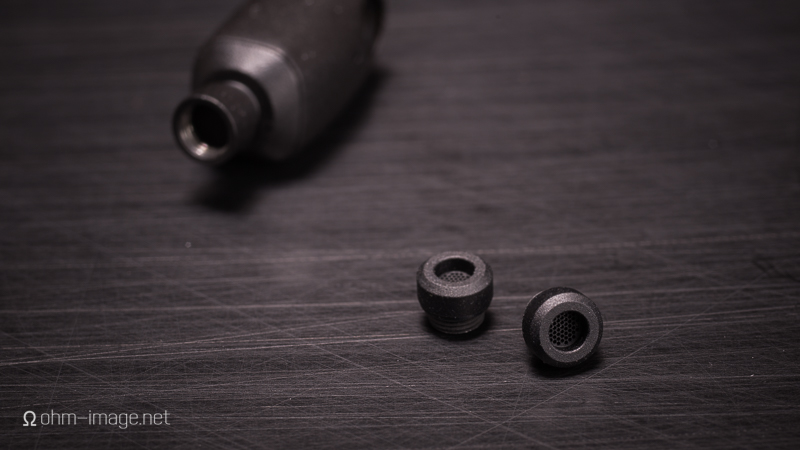Disclaimer: Jays supplied the q-Jays reviewed herein at no cost. Many thanks.
Subject:
Jays q-Jays: 400$ USD.
The original q-Jays was toyish, and, as evidenced by myriad cable breakages, ill-prepared for portable use. But because it salamandered into even the smallest ear, it was marvellously comfy. Its size, fit, and signal clarity bowled over many earphone lovers. Today’s q-Jays is nothing more, and nothing less than a brilliant, iterative upgrade to the original.
Spec:
Type: Custom dual balanced armatures
Sensitivity: 50 Ohm @ 1 kHz
Impedance: 103 dB @ 1 kHz
Frequency response: 5 – 20 000 Hz (Full); 8 – 16 000 Hz (+/- 5 dB)
Made in China
ohmage & porridge: haptics
The new q-Jays's slim body slides right in. It comes anchored by silicon and/or Comply ear pads, and you can shoehorn it into Shure’s yellow foams.
The new, stainless steel body and its brilliant, if frustrating threaded screw mounted MMCX connectors are ready for the throw-around, and the quick yank-out. But, its body, which lacks both L and R markers, not to mention standard red/blue indicators on its cable, is poorly labelled.
q-Jays is comfy worn either over or under the ear. Swapping ear pieces and channels allows you to adjust fit to the idiosyncrasies of your ears. Its proprietary threaded MMCX cable and narrow-diameter jack preclude the use of typical after market cables. It’s not all porridge though: because they don’t snap into place, the threaded MMCX plugs should take abuse with greater alacrity than normal MMCX cables and jacks.
ohmage & porridge: kitsch and quality
Its business-black, tight, and cleverly laid-out packaging, are Porsche-like in their attention to detail. There is no kitsch anywhere.
On a practical front, the L-shaped plug ensures less lateral stress on both its male bits and players’s jacks whilst sliding easily into most phone cases.
Jays 2,0 design, made famous by Yodobashi Camera-friendly sliding plastic coffins, was revolutionary, if impractical. It was a welcome rejoinder to the dark days of Jays 1,0. Jays 3,0’s design is traditional, clean, and impeccably branded. It is aimed squarely at the up-and-coming rather than the lazy trender who's recent uncovering of a few bills between sofa cushions allowed them to something colourful.
ohmage: sound
The same crystal clarity and in-your-face stereo imaging of the original made the 3,0 cut. Next to the Audio Technica CK10, highs are slightly rolled back; next to the ER4, they are smooth. If you’re a fan of either phone, today’s q-Jays may speak strongly to you.
Forward cymbal edges are splash-free; decay is similarly quick. Transitions from both extremes into and out of mids are uncluttered, accent-free, but ultimately close. Digitally edited vocals err slightly warm. Midrange stereo spreads tightly around the head, with very little z-axis depth, but in a tightly prescribed, and y-axis truncated sphere. It is tightly controlled, and fast: heavy-heeled enough for trance, and open enough for progressive.
Bass translates perfectly into the midrange. But it is lightweight, both against equal loudness curves, and against today’s hybrid-driven norm. Even by way of comparison Oriveti’s Primacy, it murmurs. Of course, I came from the CK10 and ER4 camp. I’m Mr. Lean. I appreciate the all-air-no-foot presentation. But I have also come to appreciate subjectively the feel warmer, pushier bass presences elicit in music. q-Jays translates next to no bass feel into music. You hear it. It hits light and, without a trace, disappears. Given the right amount of recording sound pressure it can hit low, but with such little force, that organic texture in guitar, upright bass, and other organic instruments, practically disappears.
A piff piff piff can never replace a poom poom poom.
It’s an anachronistic sound. The sound of 2009, but in 2016, when hybrids are pushing the envelope. Of course, the original q-Jays never pushed the technical envelope; it pushed neutrality when neutrality was still a thing. It smoothed out a few kinks in the CK10 sound, and exulted the ER4s sound. Today is yesterday. And my opinions are tempered by the contemporary trend toward neutrality as defined by equal loudness curves, and a new-found interest in mid-wide sound.
But q-Jays’s simplistic, machine-read neutrality, is both refreshing, and a reminder of the earphones that lured me away from speakers.
ohmage explained
q-Jay’s marketing, build, ergonomics, and sound, are on-again off-again brilliant. The company's newly minted branding is aimed at posterity, and the new q-Jays should make it to your kid’s 50th. The old q-Jays were just as comfy. But they broke down. And they pushed the iMac candy design years after it was cool. Today’s q-Jays has grown up. That is, except for its sound, which has been Peter Paning around since last decade- and honestly it’s hard to fault it for that.
ohmage: 3
porridge: 2
Second opinions:
1. Headfonics: The q-JAYS IEM by Jays
2. Headfonia: JAYS QJAYS Review









